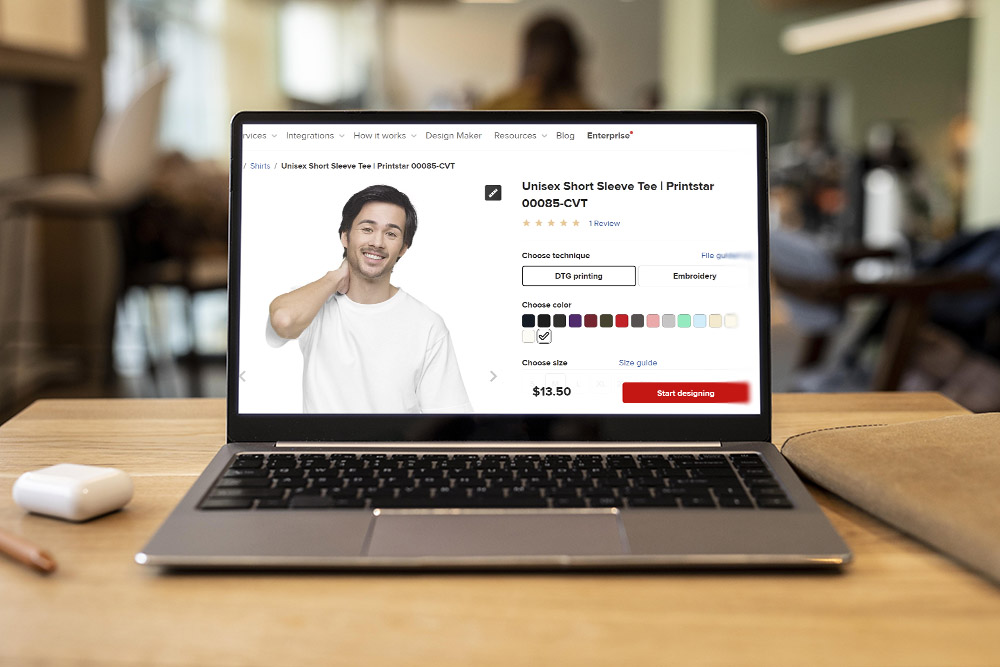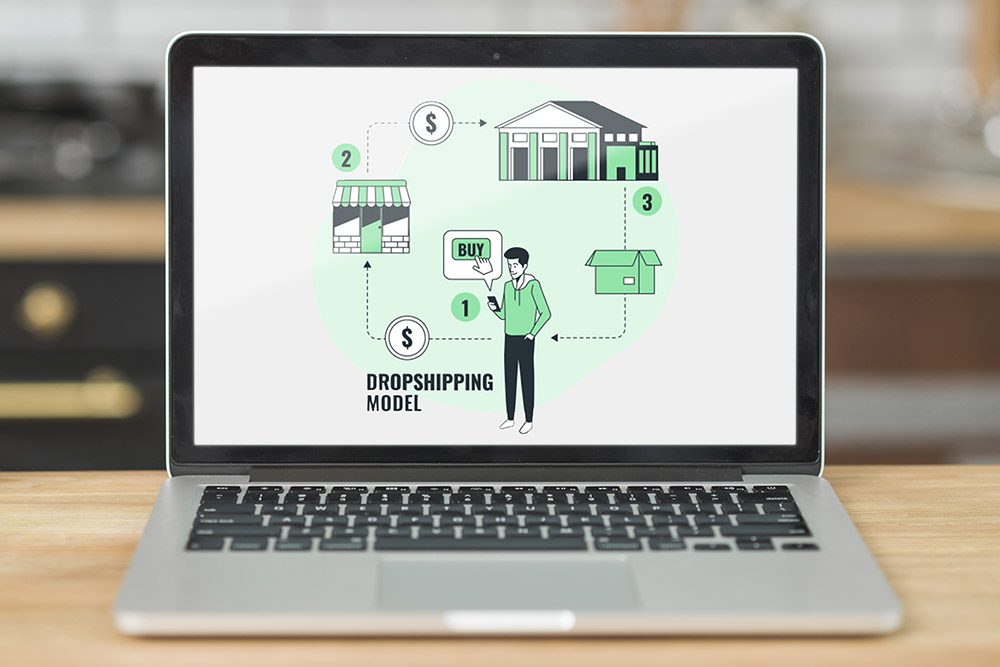Entrepreneurs often find themselves at a crossroads when choosing the most effective business model for their online store. With a myriad of options available, two popular choices – print on demand and dropshipping – stand out, but selecting the right one can be a daunting task.
Each comes with its unique set of benefits and challenges, making it crucial for business owners to understand their distinct features to make an informed decision.
In this blog post, we will delve into the nuances of print on demand and dropshipping, providing a comprehensive comparison to help you determine which approach aligns best with your business goals. From the intricacies of inventory management to the subtleties of product customization, we will explore how these methods differ and what they mean for your business operations.
Contents
What is Print On Demand?

Print on demand (POD) is a business model where products, such as apparel, accessories, or home décor, are produced only when an order is received. This allows businesses to offer a wide variety of products without having to invest in large amounts of inventory.
For example, a POD business can offer customers the ability to personalize eco-friendly t-shirts with their own designs, artwork, or text. Using a print on demand model, the business collaborates with a supplier who prints, packages, and ships the t-shirts directly to customers upon order.
Their primary audience includes environmentally conscious individuals, ranging from young adults to middle-aged customers, who value sustainability in fashion and seek unique, personalized clothing.
Pros And Cons of Print On Demand

Print on demand stands out for its cost-effectiveness, offering businesses a per-order production model that minimizes inventory costs and encourages innovation with a low upfront investment. Customization options enhance brand recognition, while scalability allows for flexibility in meeting demand. The eco-friendly approach aligns with sustainability principles.
However, challenges include limited control over product quality and potential delays in fulfillment due to the per-order system. Higher per-unit costs, constraints on customization, and reliance on third-party suppliers add complexities.
Supply chain disruptions and managing customer returns require strategic navigation. Businesses must weigh these factors to optimize the advantages and mitigate challenges in the print on demand landscape.
What is Dropshipping?

Dropshipping is a business model where a retailer sells products without having to keep them in stock. When a customer places an order, the retailer simply forwards the order details to a third-party supplier, who then ships the product directly to the customer.
For instance, one can have a business that operates as an online store specializing in the latest consumer electronics and accessories. The business adopts a dropshipping model, partnering with various manufacturers and suppliers who handle inventory and ship products directly to customers upon order.
The product catalog can feature a diverse range of items, including smartphones, smartwatches, headphones, portable chargers, and unique tech accessories. The selection is regularly updated to include the latest gadgets and technological advancements.
Pros and Cons of Dropshipping
Dropshipping embodies a business model that combines enticing advantages with inherent challenges. Entrepreneurs are drawn to its low-risk, low-investment nature, offering minimal upfront costs and reducing barriers to entry. The absence of inventory management responsibilities allows businesses to focus on key areas such as marketing and customer service.
However, this model comes with its share of drawbacks, including limited control over product quality, lower profit margins, restricted branding opportunities, potential shipping delays, and a significant dependency on suppliers. Navigating the pros and cons requires careful planning, strategic execution, and a thoughtful approach to supplier relationships for a successful dropshipping venture.
Similarities And Differences Between Print On Demand and Dropshipping

Print on demand and dropshipping are two popular e-commerce business models that allow entrepreneurs to sell products without having to manage inventory. Both models offer a number of advantages, including low upfront investment, flexibility, and the ability to reach a wide audience. However, there are also some key differences between the two models that should be considered before choosing one.
| Feature | Print on demand | Dropshipping |
|---|---|---|
| Product creation | Products are printed upon order | Products are pre-manufactured |
| Customization | Highly customizable | Limited customization options |
| Inventory management | No inventory required | No inventory required |
| Profit margins | Lower profit margins | Higher profit margins |
| Control over product quality | Limited control | More control |
| Upfront investment | Low upfront investment | Low upfront investment |
| Shipping and fulfillment | Handled by print on demand supplier | Handled by dropshipping supplier |
| Product range | Limited | Wide |
| Scalability | High | High |
| Environmental impact | Lower | Higher |
| Reliance on third-party suppliers | Handled by the dropshipping supplier | High reliance on dropshipping suppliers |
| Risk of stockouts | Low | Higher |
| Potential for supply chain disruptions | Low | Higher |
| Challenges in managing customer returns | More | Less |
| Potential for copyright infringement issues | High risk of copyright infringement issues | Lower risk of copyright infringement issues |
Similarities between Print on Demand and Dropshipping
- No Inventory Management: Both print-on-demand and dropshipping eliminate the need for businesses to keep and manage physical inventory. This significantly reduces the overhead costs associated with storing, packaging, and shipping products.
- Low Upfront Investment: Both POD and dropshipping require minimal upfront investment, making them accessible to entrepreneurs with limited capital. This allows businesses to start with a smaller initial investment and scale up gradually as their sales grow.
- Wide Product Range: Both POD and dropshipping offer a wide variety of products to sell without the need to invest in large amounts of inventory. Businesses can access a diverse range of products from various suppliers, providing customers with ample choices.
- Scalability: Both POD and dropshipping are highly scalable business models. As demand increases, businesses can easily adjust their product offerings and fulfillment processes to accommodate growing sales without the constraints of managing physical inventory.
- Focus on Marketing and Customer Service: Both POD and dropshipping allow businesses to focus on marketing, customer service, and other value-adding activities instead of spending time on inventory management and fulfillment.
Differences between Print on Demand and Dropshipping
- Customization: Print on demand offers extensive customization options, allowing businesses to create unique designs and personalized products for their customers. Dropshipping, on the other hand, typically offers limited customization options, as products are often pre-made by suppliers.
- Profit Margins: Print on demand businesses typically have lower profit margins compared to dropshipping businesses. This is because print on demand suppliers incur the cost of printing each item individually, while dropshipping suppliers often purchase products in bulk at lower prices.
- Control over Product Quality: Print on demand businesses have less control over the final quality of their products, as they rely on their print-on-demand suppliers for printing and fulfillment. Dropshipping businesses typically have more control over product quality as they may be able to inspect and test products before shipping them to customers.
- Supply Chain Disruptions: Both print on demand and dropshipping are susceptible to supply chain disruptions, but POD businesses may be more vulnerable due to their reliance on print-on-demand suppliers. Delays in printing or shipping can directly impact customer satisfaction.
- Copyright Infringement Issues: Print on demand businesses need to be extra vigilant in ensuring that their designs do not infringe on any copyright or trademark laws. Dropshipping businesses may have less risk of copyright infringement as they are typically selling pre-made products.
In summary, both print on demand and dropshipping offer viable business models with distinct advantages and disadvantages. The choice between the two depends on factors such as the type of products being sold, the desired level of customization, and the overall business goals.
Which Model is Better for Your Business?

Determining whether print on demand or dropshipping is better for your business depends on several factors, including your niche, target audience, profit goals, level of experience, and desired level of control over your products. Here’s a breakdown of the key considerations for each model:
Who is suitable for print on demand?
Print on demand is particularly suitable for entrepreneurs and businesses that prioritize creative control and brand identity. This model is ideal for those who:
- Value Low Initial Investment: Entrepreneurs who wish to start a business with minimal upfront costs will find print on demand appealing. It eliminates the need for significant investments in inventory and warehousing, reducing financial barriers to entry.
- Focus on Design and Marketing: Those who have strengths in designing unique products and executing effective marketing strategies can thrive in a print on demand setup. This model allows entrepreneurs to concentrate on creating compelling designs and promoting their brand, while the logistical aspects of production and shipping are handled by the print on demand service provider.
- Seek Brand Differentiation: Print on demand is perfect for entrepreneurs aiming to establish a distinct brand identity. The ability to incorporate unique brand elements into product designs helps in reinforcing brand recognition and setting the business apart in the market.
- Desire Customization and Personalization: If the business strategy involves catering to customers’ desire for personalized products, print on demand is an excellent choice. It allows for the creation of bespoke items tailored to individual tastes and preferences, enhancing customer satisfaction and loyalty.
- Target Niche Markets: Businesses targeting niche markets with specific design needs or preferences will benefit from the flexibility of print on demand. It enables the creation of custom, niche-specific products without the risk of unsold inventory.
- Prioritize Eco-Friendly Practices: Entrepreneurs who are environmentally conscious may prefer print on demand as it generally results in less waste compared to traditional retail models. Products are only printed and shipped when ordered, reducing overproduction and excess inventory.

Who is suitable for dropshipping?
Dropshipping is particularly well-suited for a range of entrepreneurs and businesses, primarily those focused on financial efficiency and flexibility. This model is ideal for:
- Entrepreneurs Seeking Profit Maximization: Dropshipping is an optimal choice for those whose primary goal is to maximize profits. The lower product sourcing costs and elimination of expenses associated with inventory management contribute to higher profit margins.
- Businesses Aiming for Cost Efficiency: For those prioritizing cost efficiency, dropshipping reduces ongoing operational costs. Since the model eliminates the need for warehousing and direct handling of products, it leads to significant savings in operational expenses.
- Risk-Averse Entrepreneurs: Dropshipping is suitable for individuals who are averse to the risks associated with storing or managing physical inventory. This model minimizes the risk of unsold stock and reduces financial commitments related to product handling and storage.
- Entrepreneurs Looking for Market Flexibility: The model provides flexibility in testing and introducing new products without substantial financial risk. Entrepreneurs can quickly adapt to market trends and customer preferences, adding or removing products from their offerings with minimal impact on their operations.
- Online Retailers Expanding Product Offerings: Dropshipping is also ideal for established online retailers looking to expand their product offerings without increasing inventory costs. It allows them to offer a wider range of products without the need for physical stock.
FAQ

1. Is print on demand still profitable?
Print on demand can still be a profitable business model, especially for creative entrepreneurs, who have a strong design sense and can effectively target their niche audience. Print on demand businesses can differentiate themselves by offering unique designs, personalized products, and high-quality printing techniques.
2. Is print on demand more profitable than dropshipping?
While dropshipping generally offers higher profit margins per unit, print on demand businesses can potentially achieve higher overall profitability in the long run through increased customization, branding, and customer loyalty. The profitability of print on demand and dropshipping depends on various factors, such as product margins, sales volume, and supplier costs.
3. What is the difference between dropshipping and print on demand?
The main difference between dropshipping and print on demand lies in the timing of product production. In dropshipping, products are already manufactured and stored by suppliers, and they are shipped directly to customers upon order. In print on demand, products are not created until an order is placed, allowing for customization and personalization.

